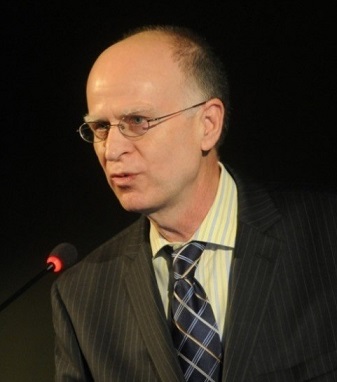
A Wayne State University School of Medicine professor was recently recognized for his many achievements during 30 years of collaboration with professional colleagues in China and his work to assist that nation in developing the use of magnetic resonance imaging.
E. Mark Haacke, Ph.D., professor of Radiology and of Biomedical Engineering, received the award June 30 during the 17th meeting of the Chinese Radiology Society MR Section in Taiyuan. The citation reads: "For your distinguished achievements in the Chinese Radiology field and outstanding contributions to MRI, we confer on you the title of 'Expert with Outstanding Contributions.'"
Dr. Haacke, director of the MR Imaging Center and vice chair of Biomedical Engineering for the School of Medicine, first visited China in the late 1980s when he ran one of the first workshops on magnetic resonance imaging in Beijing with Professor Z.H. Cho of Korea. At that time, China was just beginning to install new MRI scanners, he said. "It was an auspicious time in China, a turning point reflecting the new direction China was headed."
The country needed help in securing materials such as journals, because there was no funding for subscribing to imaging journals available in the West. The Society for Magnetic Resonance Imaging decided to assist China's growth in the field of MRI. Dr. Haacke was later elected vice president of the society, and then, as president in 1991, "made every effort to continue supporting this international collaboration in China."
More recently, Dr. Haacke has presented three workshops on stroke and traumatic brain injury, the first in Shenyang, the second in Shanghai and the third this year in Tianjin. The workshops created opportunities to bring together many of the collaborating sites in China and promote MRI research.
Many of the more than 100 graduate students that Dr. Haacke has trained came from China. Some have become leaders of imaging centers. From 1993 to 1999, he worked on a textbook, "Magnetic Resonance Imaging: Physical Principles and Sequence Design," now renamed "The Green Bible of MRI" by many of his graduate students. Since its release in 1999, it has been translated into Chinese and cited in journal articles more than 3,000 times.
A few years ago, Dr. Haacke signed an agreement with East China Normal University to develop a joint relationship between the two MR Research Centers and provide an exchange between the two universities.
"Much of our collaborative work in China has been on clinical studies of Susceptibility Weighted Imaging, also known as SWI," said Dr. Haacke, a distinguished professor of ECNU. "A few years ago, it was cited as one of the top 30 papers in the last 30 years in the journal Magnetic Resonance in Medicine. The Chinese have used this method to study everything from stroke in the brain to cancer in the abdominal organs. Today, we have continued developing SWI with students at East China Normal University to allow imaging of the brain in less than 10 minutes using new fast imaging concepts. We collaborate with many of the major hospitals in China on clinically-related projects, stroke, atherosclerosis and Parkinson's disease."